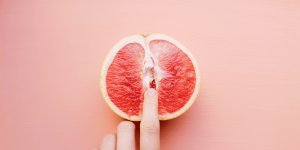Illustration by Marta Pucci
Vulvas: shapes, sizes, and misconceptions
Vulvas are extremely diverse, but that isn’t embedded into society.
People typically call the whole landscape of female genitalia the “vagina.” The visible parts, the inside, the surrounding area, the general vicinity between the legs — the vagina.
Which is incorrect. The vagina is an internal canal. Its visible part — the opening — is just a part of the many factors of the vulva: the external female genitalia (1).
Using an inaccurate term to generalize the characteristics of the female reproductive anatomy lies at the basis of misconceptions about how genitals “should” look.
Vulvas are extremely diverse, but that isn’t embedded into society. Porn is a readily available source of genital images, but it doesn’t represent the wide variety of vulval traits, nor do the anatomical images found in textbooks and on posters in medical practices (2).
Use Clue to track all things related to your vagina: bleeding, discharge, sex, and contraception.

Cultural influences like porn have led the labia minora, also known as the “vaginal lips,” to become a distinct factor in what is deemed attractive for genitalia (3). Pubic hair removal has also contributed to this notion as it exposes the genital area. Tiny labias have become glamorized and ubiquitous in the limited (and often artificial) depictions of vulvas out there (4). And this is perpetuating the idea that there is just one ideal labia, when they come in many colors, shapes and sizes.
Unreliable representations and mislabeling of the female anatomy have created baseless ideas on what is “normal.”
This is fueling insecurities and could be why more people — and in particular teenagers — are turning to genital plastic surgery such as labiaplasty for purely cosmetic reasons (3). The personal predispositions of plastic surgeons, who are more open to performing labia minora reduction procedures in the absence of physical complaints, could also be influencing this trend (5).
Genital plastic surgery is a personal choice and someone’s reasons for undergoing surgery, whether as a way to feel more comfortable about themselves, alleviate a painful abnormality, for sex reassignment, or any other reason, are deeply individual. Pressure to fit aesthetic “norms” and to meet absurd cultural standards of beauty, however, are not helpful or positive contributions towards a person’s decision and are alienating to the majority of vulva owners.
Thanks to photographers Katie Huisman and Nick Karass, as well as artists Jamie McCartney, Katja Tetzlaff and Club Clitoris, accurate vulval variation is being exposed. Their art is contributing to a crucial need for a resource of inclusive genital diversity, including intersex anatomy.
People’s bodies need to be properly understood, represented and respected.
Positive genital self-image correlates with greater sexual self-esteem (6). And feeling sexually attractive is surely a good thing for your overall self-esteem and intimate relationships. There is still a long way to go in portraying female, intersex and trans genitalia, as well as dismantling the narrow and damaging vulval archetype.
Do you think there is a pressure to conform to unrealistic genital beauty standards? Share your thoughts with us @clue.

